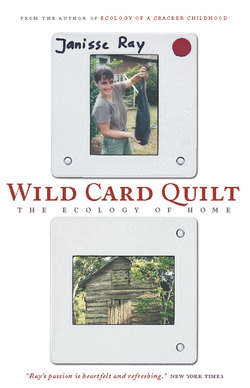Читать книгу Wild Card Quilt - Janisse Ray - Страница 12
На сайте Литреса книга снята с продажи.
ОглавлениеFinding Wiregrass
Out walking on the farm I found a few clumps of grass that made my heart lurch. Unsure at first, I ducked under the electric fence that keeps the cows in and put my knees into the hot dirt.
Wiregrass.
Funny how a few clumps of grass could make me want to do a jig out there in the cow pasture.
When Cracker settlers first crossed the Altamaha River into what had been Creek hunting grounds, they found a forest we can now only imagine. The entire Southeastern uplands grew longleaf pine, 93 million acres of it from southern Virginia to east Texas. Now you can find little pieces; but out of 93 million, only 3 million acres of natural forest (meaning forest that regenerated naturally, consisting of trees of all ages) remain.
The longleaf pine can’t be talked about as a tree, really, but as an intricate and intriguing ecosystem. The original forests held a legion of animals that had evolved to live in them: red-cockaded woodpeckers that bored out cavities in old-growth heart-pine trees; fox squirrels; and stunningly docile indigo snakes. Gopher tortoises, a long-lived species of land turtle, dug long burrows in the ground that became home to more than 300 other species, especially when the woods burned. Diamondback rattlers found refuge in the holes, along with gopher frogs, gopher snakes, scarab beetles.
You can’t talk longleaf without talking gopher tortoise, nor tortoise without indigo snake, nor the snake without gopher frog, nor the frog without flatwoods salamander, nor salamander without Bachman’s sparrow. You can’t talk mole cricket without talking indigo snake. The list goes on and on.
Although a pine flatwoods usually grows only a single species of tree, an incredible diversity of flora can be found in the ground cover. But one kind of grass grows most commonly beneath longleaf pines, and that is wiregrass—tough, wiry, flammable. Mixed in with the wiregrass, a panoply of grasses and wildflowers prospers: toothache grass, meadow beauty, pine lily, orange fringed orchid, Kentucky bluegrass. Per square meter, this ecosystem is as diverse as it gets. You have to crawl around on your hands and knees to see everything.
Periodic wildfires thwart the encroachment of hardwoods such as oak and sweet gum into the pinelands, so the trees have evolved not only to survive fire but to depend on it. Wiregrass has evolved toward flammability to help push fire quickly through the forest, and it needs burning in order to reproduce well. Some of the forbs that grow with wiregrass won’t even seed unless they have been scored by fire. Afterward, new ground cover springs lush and green from the ashen ground.
Just as longleaf pine is lashed to fire, a marvel of species is tied to longleaf pine, and the pine is laced to the highly diverse understory—the grasses and forbs, such as curtis dropseed and summer-farewell and blazing star—that is also bound to fire. The animal inhabitants are tied to the understory. Amazing the way everything is woven together.
Because most of the ancient forests have been cut, you don’t see red-cockaded woodpeckers or gopher tortoises or indigo snakes or fox squirrels or even diamondback rattlers much anymore. You don’t see wiregrass. But in a ribbon of woods that borders the cotton field, I found a little patch. Imagine my joy, because where a few clumps of wiregrass linger, there’s no telling what else remains.
